Good morning and welcome back to another Grand Art Tour here in the Mirror Gallery on Hipsters of the Coast!
Modern Horizons 2 officially releases tomorrow, and has had some of the most exciting artwork of the year so far, comprising 292 brand new illustrations spread across all colors, rarities, types, frames, styles, and mediums. This was by far the hardest selection process in the two years I’ve been writing Grand Tours, not only because the sheer number of new illustrations, but the unprecedented quality and innovation of the art present within this set.
In case this is your first Grand Tour, this ongoing series was inspired by New York Magazine art critic Jerry Saltz and his 2010 article A Grand Tour. More than 10 years ago, Saltz wrote about his exploration of his favorite works on view in New York City that summer; not only why he’d gone to see them, but why you might want to as well. This article has much the same purpose, to illuminate the narrative within these works, and explain past card size why they’re simply extraordinary. And whereas my Strixhaven Grand Tour was almost completely digital artworks, this article, save for one piece, features all traditional work. This is not something I plan as I don’t caption the images until the end, but interesting nonetheless.
Without further ado and in no particular order, these are my favorite works from Modern Horizons 2.
Yavimaya, Cradle of Growth by Sarah Finnigan
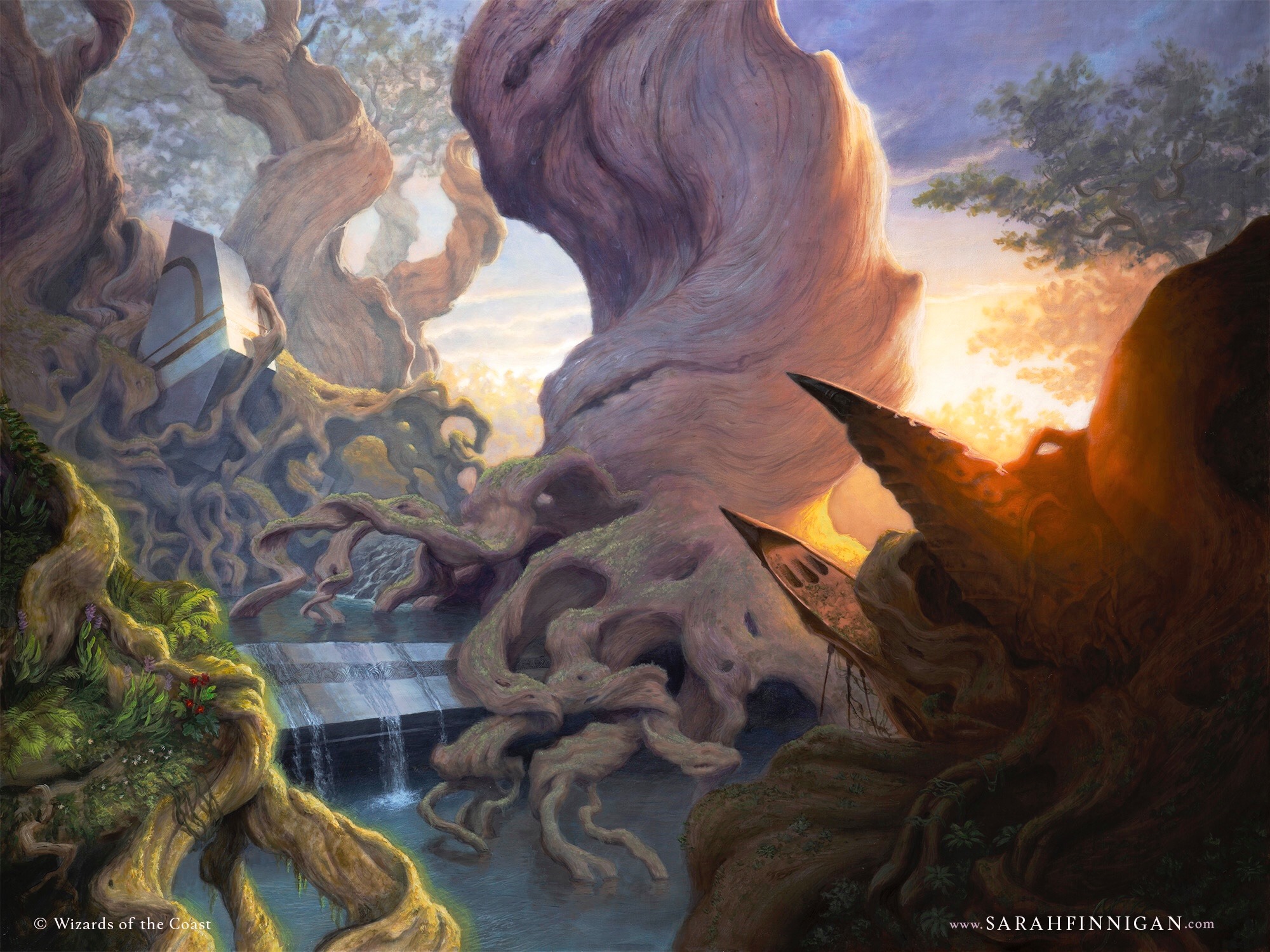
Yavimaya, Cradle of Growth by Sarah Finnigan, acrylic on board, 18” x 24”
Sarah Finnigan follows up her MTG debut from Kaldheim with another incredible landscape, this time depicting one of the most famous and well-known places in all of Dominaria. This is everything you could want from a fantasy landscape; it’s grounded in realism but has all the myth and magic of a far away land. I love the light that peeks through the center of the image: it’s the dawn of a new day on Dominaria, and the perfect piece to start this article.
Titania, Protector of Argoth by Iris Compiet
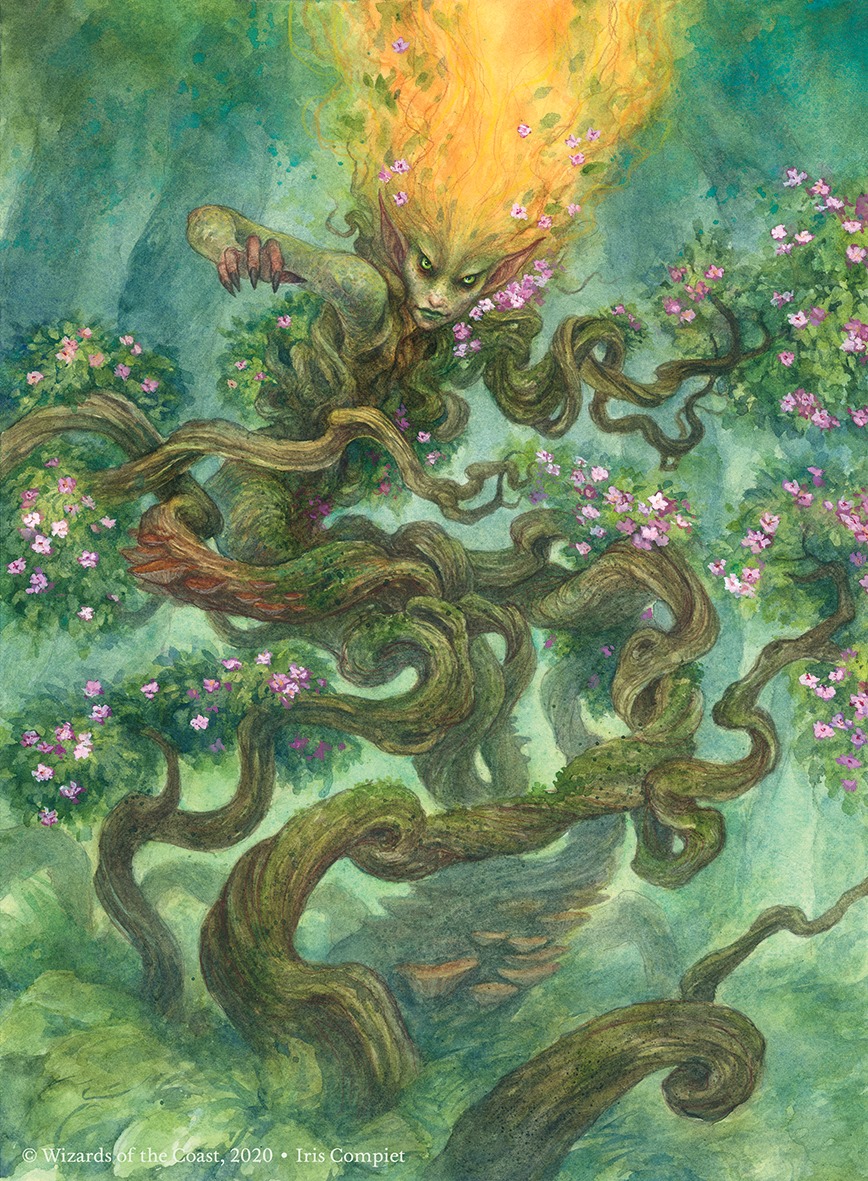
Titania, Protector of Argoth by Iris Compiet, watercolor, gouache, and col-erase pencil on Arches 300 grams paper, 8.6” x 11.8”
Outside of Magic, Iris is well-known for her illustrated compendium Faeries of the Faultlines, and I have no doubt it was her resonance with those thin places that brought Titania forth in fantastic fashion. We see the age-old legend in her pure elemental form, complete with lush leaves and writhing boughs, rendered traditionally in watercolor and gouache; it’s old Magic made new again. This is a match made in heaven for artist and commission: Iris was the absolute perfect choice to illustrate this character, and she knocked it out of the park.
Brainstone by Drew Tucker
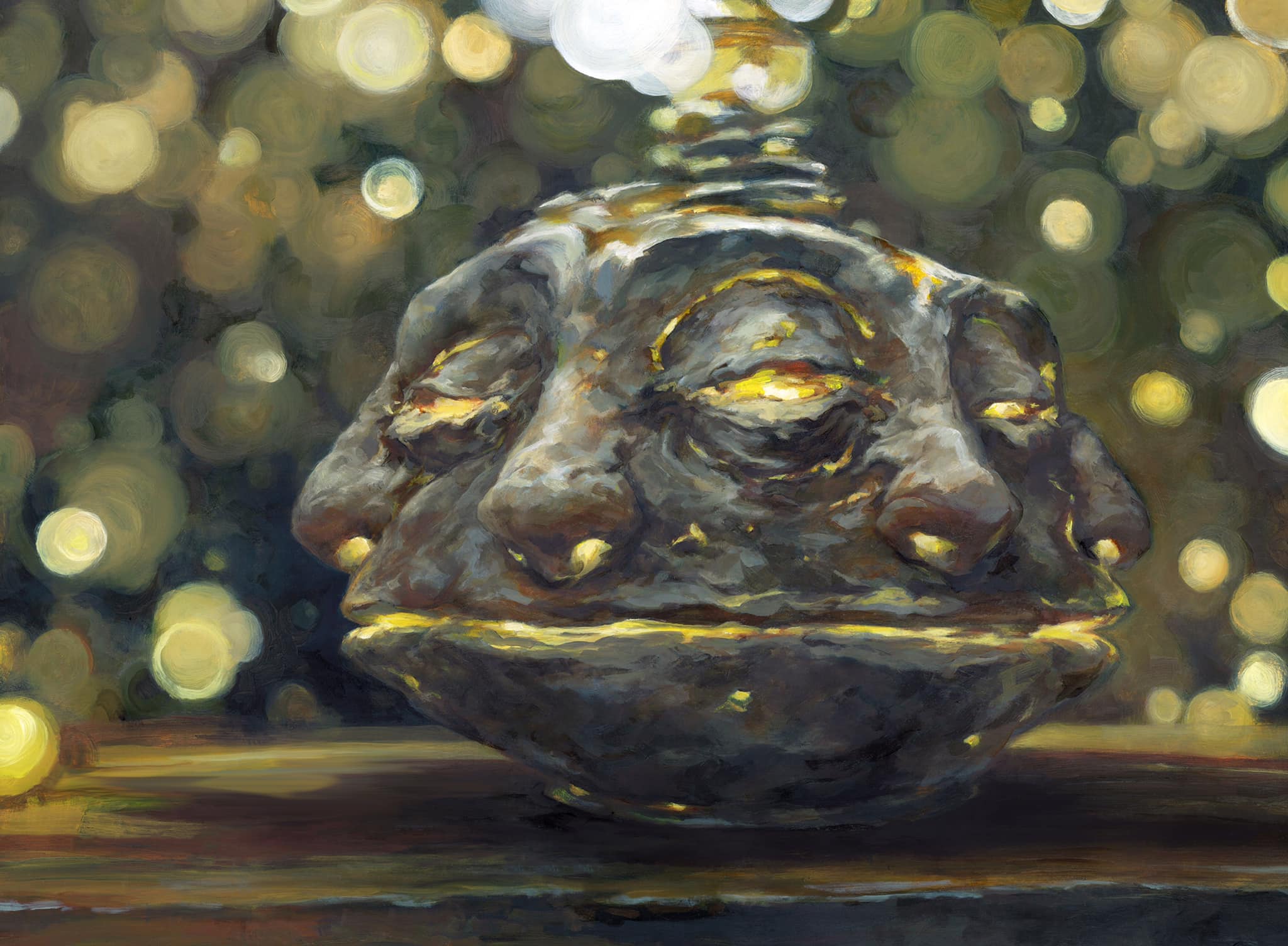
Brainstone by Drew Tucker, oil on Masonite Board, 18” x 24”
Drew Tucker makes his return to Magic in Modern Horizons 2 with his first cards in more than a decade! One of Magic’s first 25 artists, he has five different works in this set, and each is a shining example of his style that feels like the early days of Magic but works for the needs of the game today. The first to be revealed was Brainstone, and this piece is straight mesmerizing: you can get lost in the twinkle of the lights in the background, and if you follow the face of the Brainstone close enough, it even feels like it’s about to spin. I’d like to give a big welcome back to Magic to Drew Tucker, and big ups to Art Director Cynthia Shepherd for bringing him back: I hope we get to see more soon!
Late to Dinner by Kev Walker
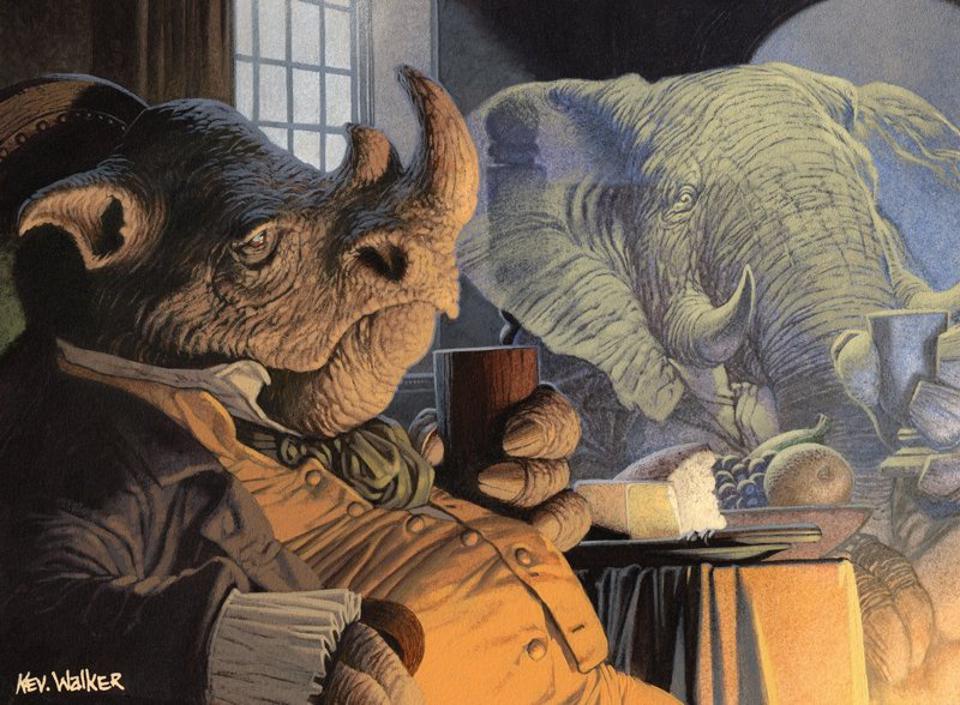
Late to Dinner by Kev Walker, mixed media
This is one of those cards where I hope the story continues in some form in another set, so that we get to know these two characters better. If you didn’t catch exactly what’s happening in the image, the flavor text reveals what we see:
“I knew you were set in your ways, friend, but even I didn’t expect you to keep our engagement, under the circumstances.”
These two friends must’ve had a regular dinner meeting, and even though things aren’t quite the same (you’re seeing it right, the Elephant is a ghost), their commitment will continue. The intense lighting from the fire before them creates a peaceful calm and at the same a bit of uneasiness due to the unusual circumstances. It takes a master to pack that much narrative into a couple inch box, but Kev Walker has been doing just that since 1996, and he continues to be one of the longest illustrating and most prolific artists in the game’s history.
Sword of Hearth and Home by Randy Gallegos
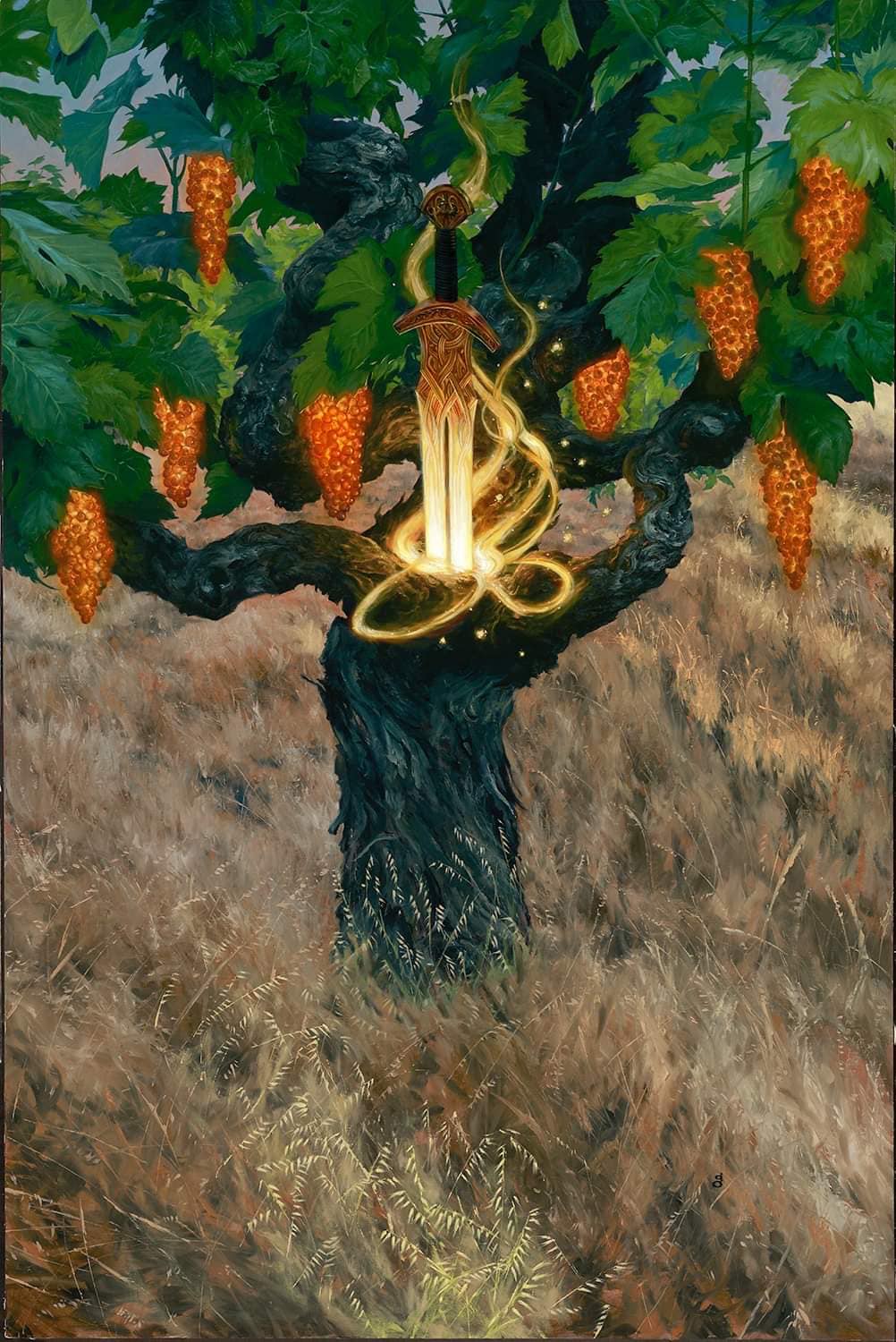
Sword of Hearth and Home by Randy Gallegos, oil on cradled wood panel, 24” x 36”
This painting, an Excalibur-esque depiction of one of Magic’s two-color swords, is another example of an artist drawing inspirationing from their larger body of personal work. Randy has done some absolutely breathtaking California landscapes (seen here), and has used that as a vehicle to create this work of imaginative realism within the Magic Universe. He spoke about the connection on Facebook:
“I’ve had a few instances where I’ve been able to bring outside interests into my Magic illustration in recent years: my still life painting, my experiences living around the burned out areas of Sonoma County wildfires, and now this. Being able to apply these outside influences is something I enjoy and I hope lends an occasional unique flair to the game.”
These grape clusters have also been dubbed “manaberries,” so if you pull this card over the weekend, don’t forget!
Silverbluff Bridge by Joseph Meehan
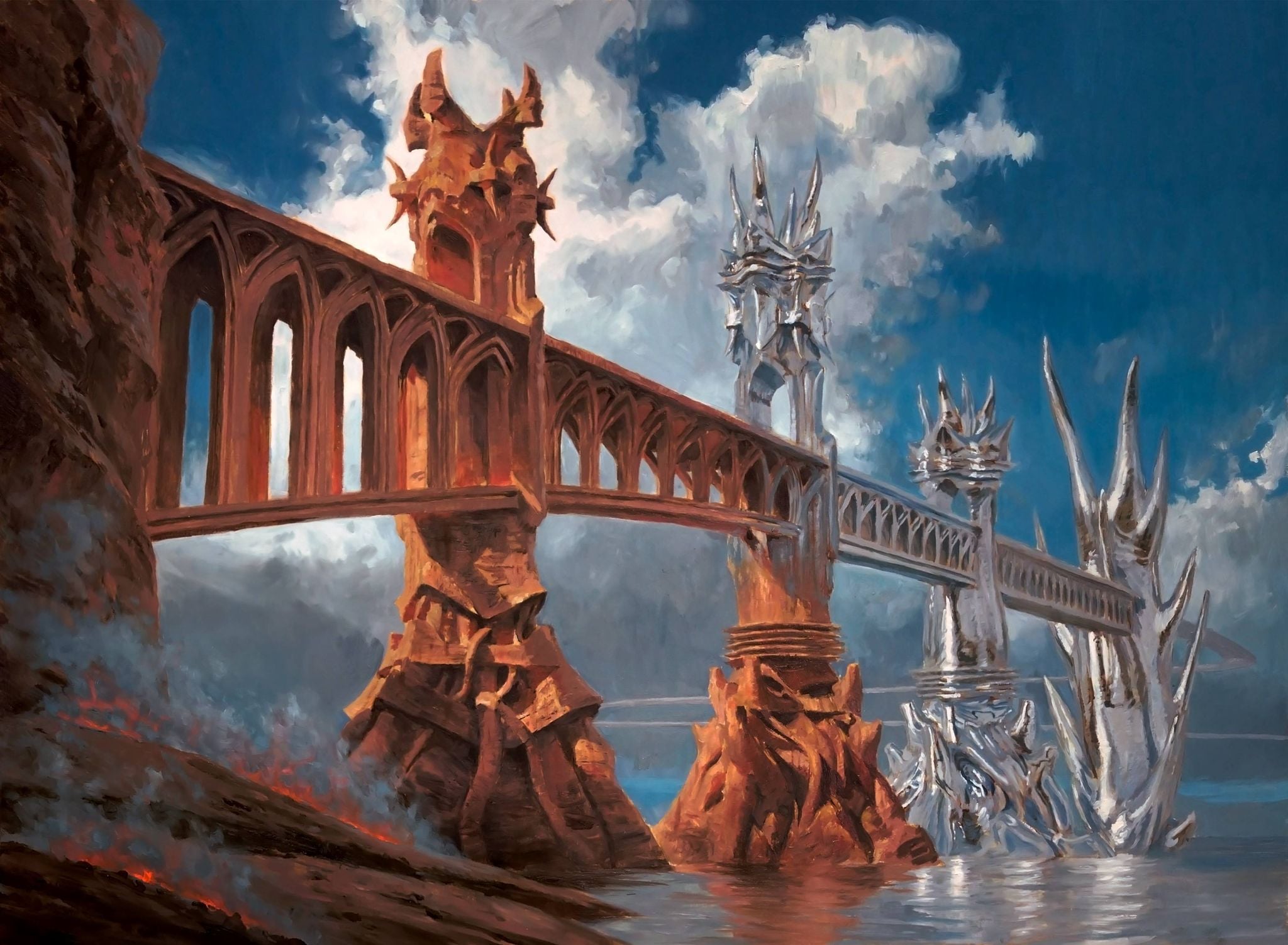
Silverbluff Bridge by Joseph Meehan, oil on paper on board, 20.5” x 28”
I’m not quite sure how Joe Meehan is able to tow the line between hyper-realism and impressionism so well, but that’s exactly what we have in Silverbluff Bridge. It’s impressive and stately, as a bridge seen from below would be, but has all the elements that set this location squarely on Magic’s metal plane of Mirrodin.
I know I’ve said it before but I’ll say it again: these pieces that stand out, especially the landscapes, are so good because they are the real re-imagined. It’s a crucial element oft forgotten, but something Meehan has absolutely mastered.
Grist, the Hunger Tide by Victor Adame Minguez
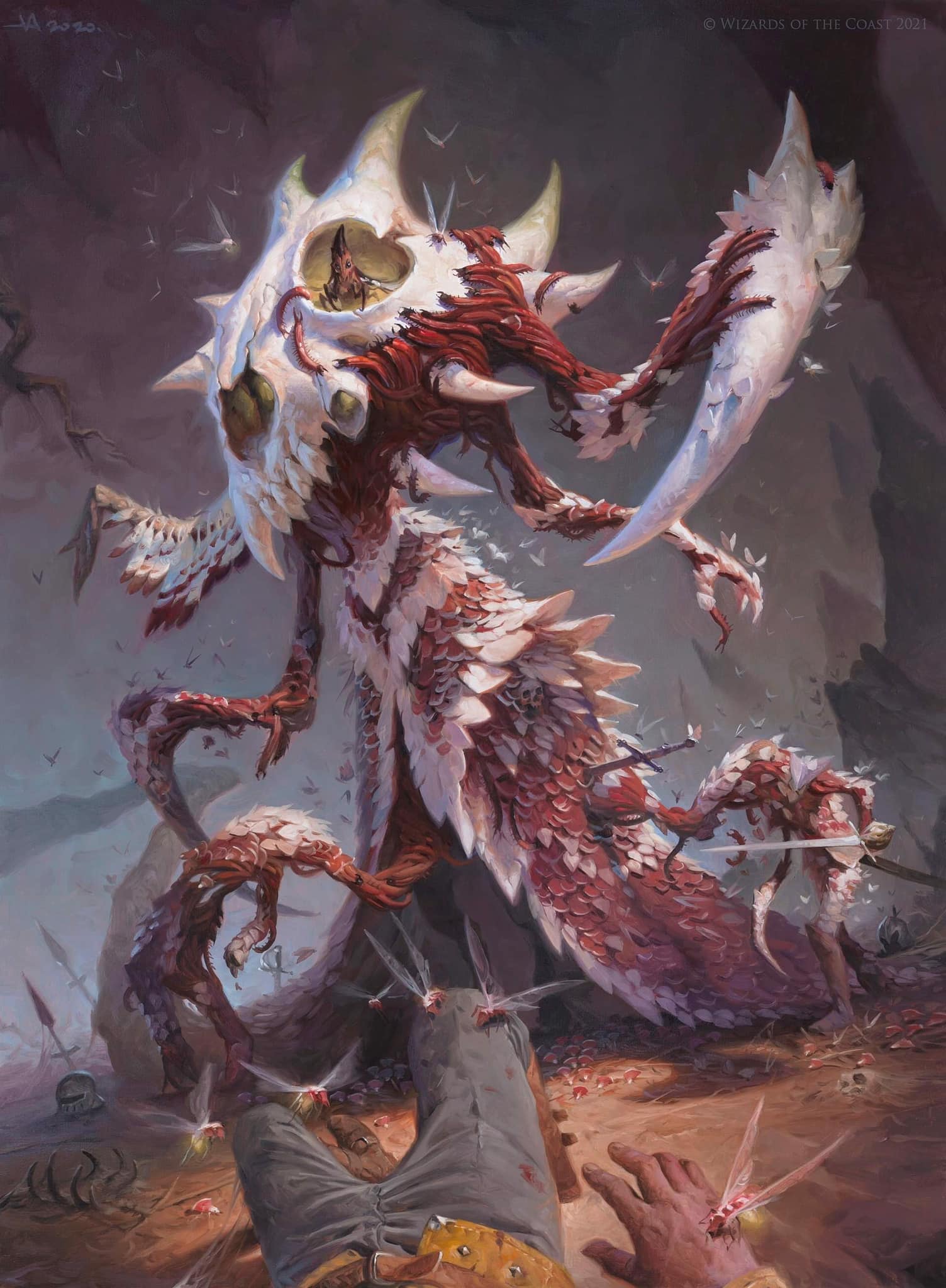
Grist, the Hunger Tide by Victor Adame Minguez, oils on gessoboard, 10.5” x 14.5”
This painting is absolutely harrowing in all of the good ways: incredible details, an exceptionally challenging composition so very well executed, and a narrative to die for. You can’t see it at card size because of the text box, but Victor has placed the viewer at the feet (foot?) of this humanoid Planeswalker, and it is us who are about to meet our fate as we gaze us at the literal pile of flesh and bone.
Victor is one of those artist’s who is constantly on my short list for these Grand Tour articles, and is just continually getting better and better. This painting sold almost instantly for $35,000 on the MTG Art Market, and it seems like folks are finally catching on to the sheer quality of his work.
Mirari’s Wake by Donato Giancola
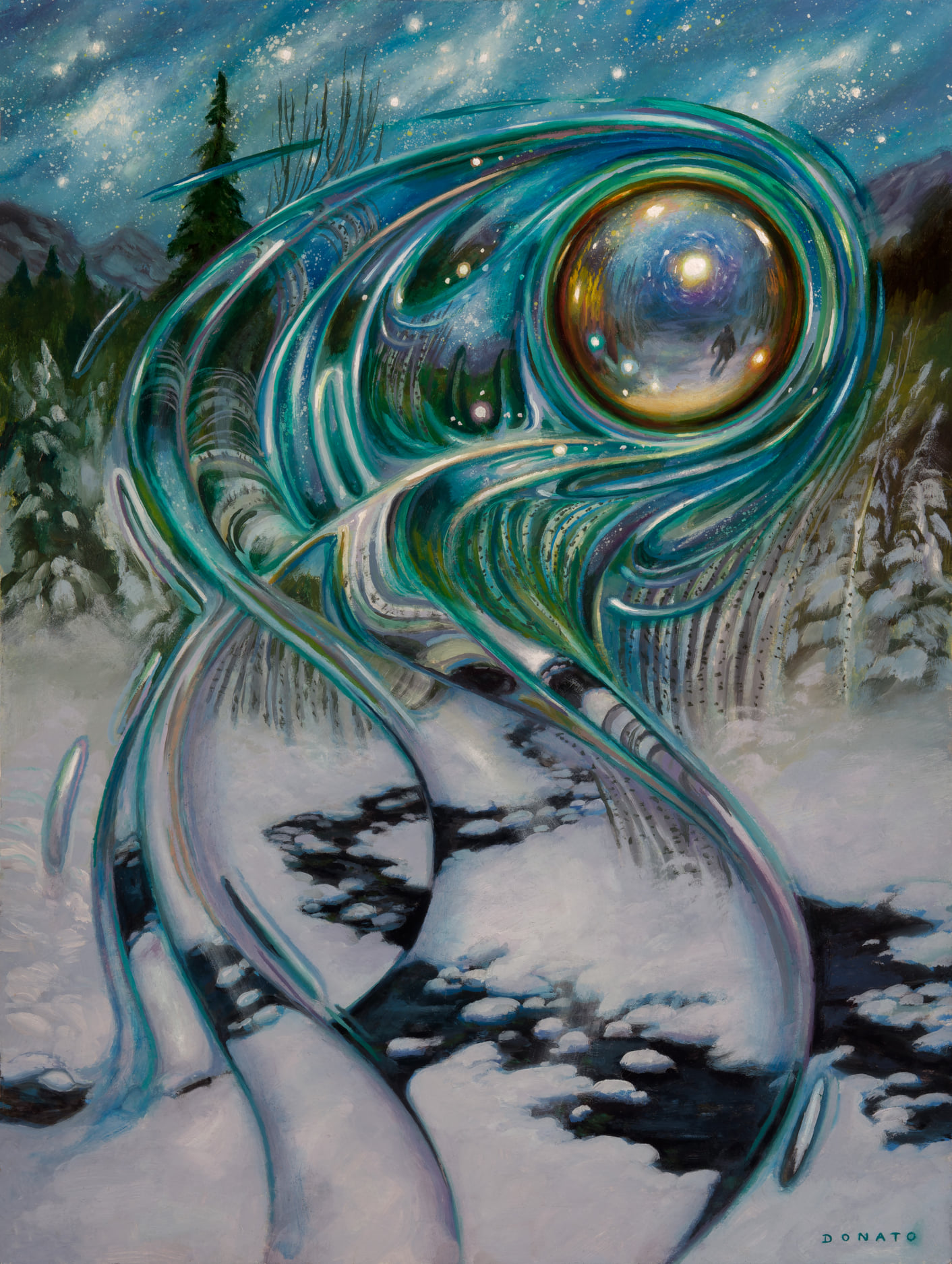
Mirari’s Wake by Donato Giancola, oil on panel, 12” x 16”
Donato was responsible for the first and original illustration of the Mirari, the “orb of desire” as it was so called that (literally) shaped Magic’s storyline in the late 1990s and early 2000s. Giancola has put the power and might of the Mirari on full display as it warps all that is around it, rendered perfectly legibly in oil paint. And look close: the original Mirari showed a reflection in the orb itself, and retains that same reflection here, an easter egg more than twenty years in the making.
Sanctum Prelate, Sanctifier en-Vec, and Blossoming Calm by Michael C. Hayes
Sanctum Prelate, Sanctifier en-Vec, and Blossoming Calm by Michael C. Hayes, oil on board, 12” x 16” to 18” x 24”
Michael C. Hayes has returned to Magic after a half dozen years away from the game, and has created three new pieces very much in the style of his personal work he showcases at places like IX. Powerful women bathed in brilliant light is exactly his wheelhouse, and each of these three pieces exemplify that. Whether it’s the glow from the prelate’s staff, the ethereal radiance of the sanctifier, or the brilliant luminosity of the spell, these beacons immediately draw your eye and capture your attention. Glad to have you back Mike, and here’s hoping it won’t be six more years until we see more cards!
Fairgrounds Patrol by Sidharth Chaturvedi
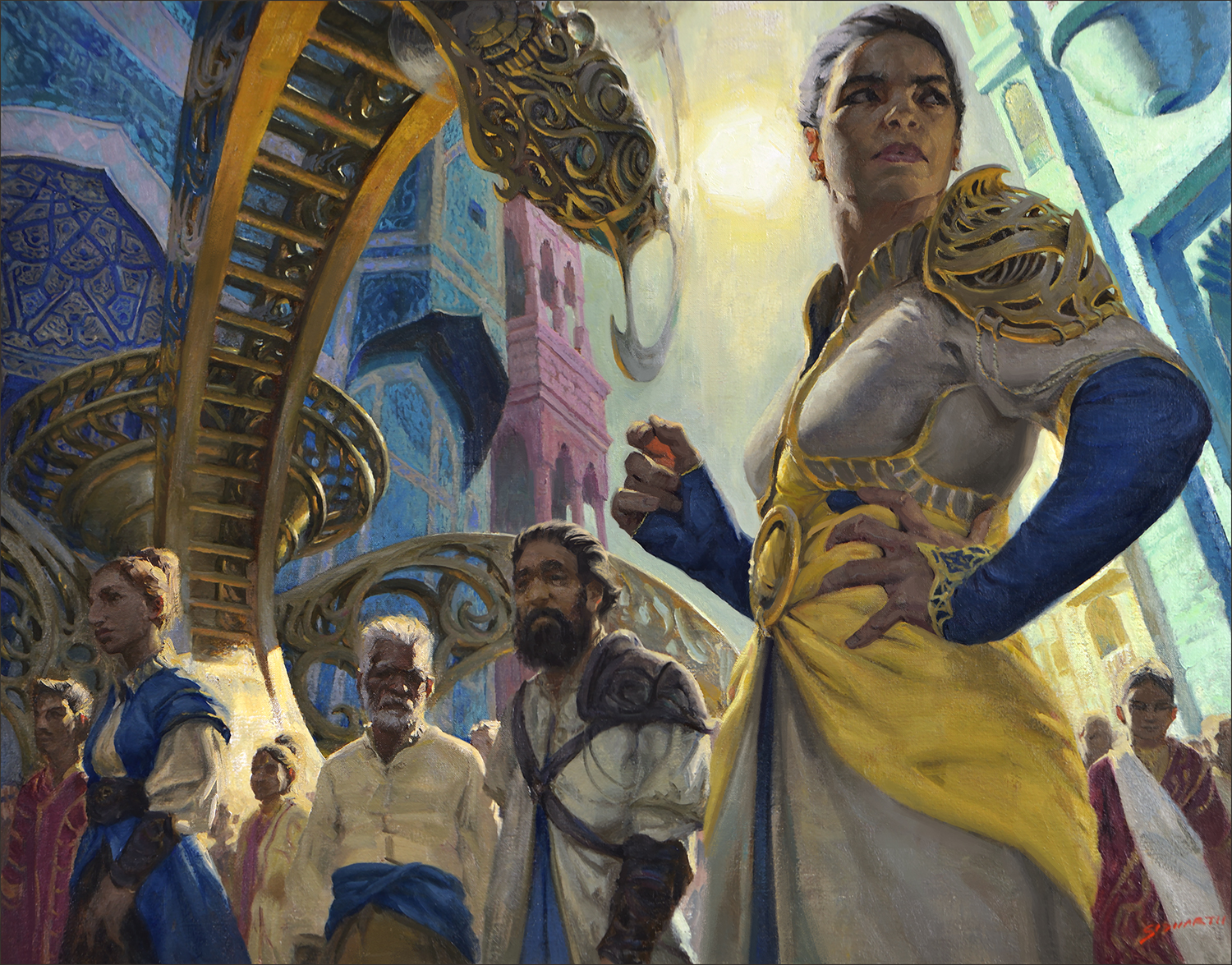
Fairgrounds Patrol by Sidharth Chaturvedi, oil on canvas, 16” x 20”
I cannot wait to go back to Kaladesh and see Sid Chaturvedi go absolutely wild illustrating the people and places from that plane, because my goodness, look at all the details here. The architecture, the filigree, the facial expressions, and one bad-ass woman, hand on hip and hand at the ready to tell you exactly what’s going to be happening. This is a Golden Age illustration for Magic’s Golden Age, and Chaturvedi continues to embody and exemplify the styles of the masters that made the genre what it is today.
Scour the Desert by Tyler Walpole
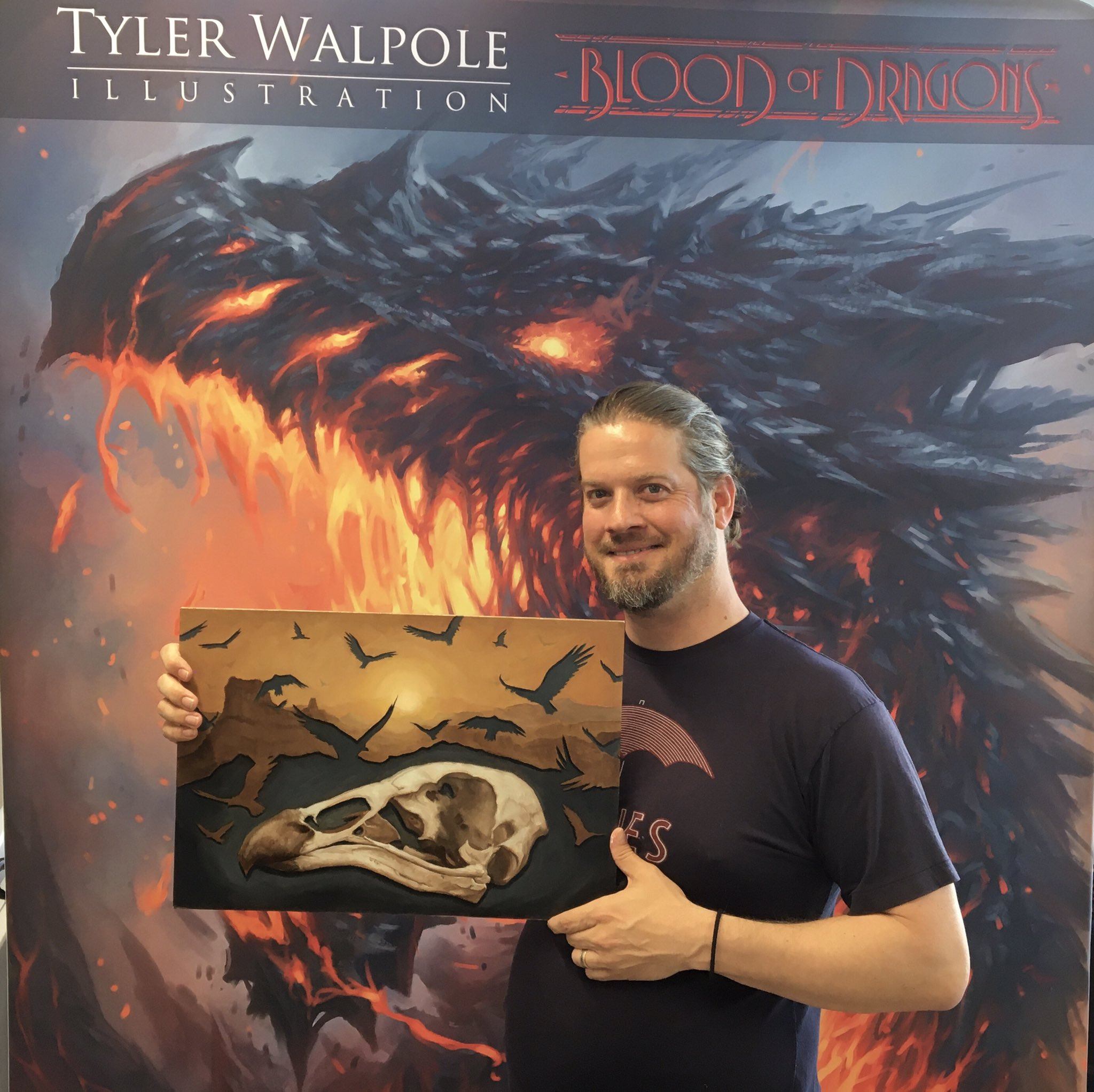
Scour the Desert by Tyler Walpole, oil on paper on Masonite, 13” x 19”
A stylistic departure from what we’ve seen from him previously, this exercise in abstraction is plain exciting to see, within Magic in general but especially from Walpole. This feels like an immense challenge, but the artist has created an artwork that not only suits the card in every respect but contains the matter of a full of a story we see unfolding in but a few words:
“Even in the most barren wastelands, every death feeds more life.”
I dig this sort of experimentation and innovation in what a Magic painting can be, and Walpole deserves big ups rising to the occasion.
Svyelun of Sea and Sky by Seb McKinnon and Howard Lyon
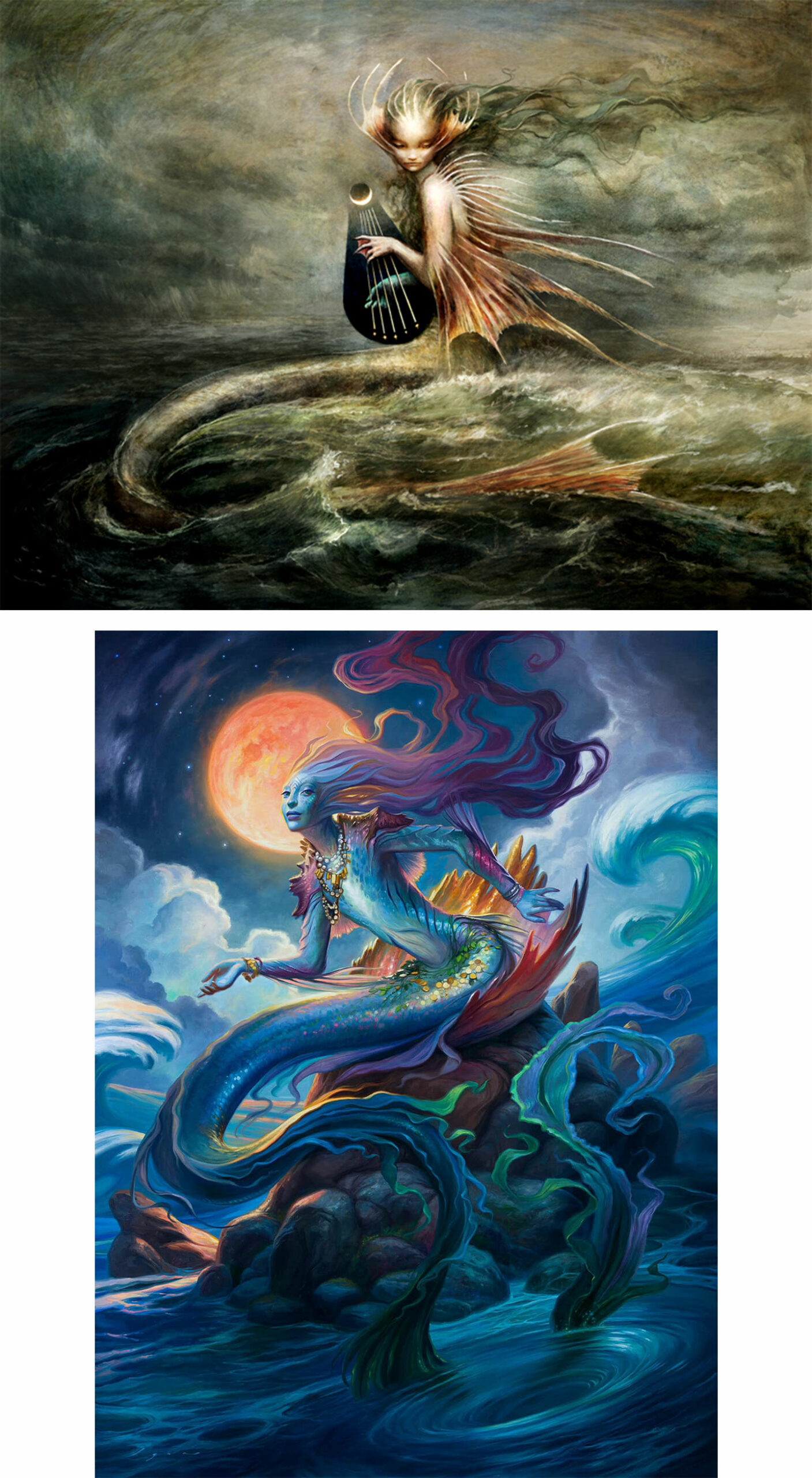
By Seb McKinnon. Digital. By Howard Lyon, oil on linen, 22” x 30”.
I’ll end today with two works from two of the giants working in the game today: Seb McKinnon and Howard Lyon. These paintings show the same legendary character in two completely different ways. McKinnon has channeled the classicism of Turner with a contemporary touch, while Lyon has given us a full-art, pre-Raphiliate-esque portrait of the same being. This is Magic art at its fever pitch, and shows the breadth of style that can exist within a game. Both perfectly executed in two drastically different styles and mediums, but both masterworks that will stand apart come award time at the end of the year.
It’s paintings like these that make you stand back and say, “Isn’t Magic great? Isn’t art great?! What a time to be able to play this game!”
Wrapping Up
I hope you all enjoyed this very brief journey through some of the standout work in this brand new set. As I mentioned before it was by far the hardest selections I’ve had to make, and I could have written this article differently a dozen times; there is just SO MUCH good artwork in this set. There are folks with massive contributions of a half dozen or more cards in the set that I couldn’t even mention—Campbell White, Lucas Graciano, Svetlin Velinov, Nicholas Gregory, Yeong-Hao Han, Anastasia Ovchinnikova, and Andrew Mar, to name just a few. It felt like everyone was doing their best work, and you can check out all the new artwork over at Scryfall following this search.
Legendary artists from Magic’s past rejoined the game, rising stars burned brighter than ever, and newcomers joined the ranks of illustrating the greatest game in the world. It’s a pleasure and a privilege to talk about what these folks are creating, and it still feels like the best is yet to come.
Remember, to see original #mtgart and other #vorthos related things, follow me on Twitter. Feel free to ask questions or retweet to continue the conversation. Thanks and see you next time!
Donny Caltrider has been playing Magic since 2002 and collecting original Magic art since 2017. He has an M.A. in Museum Studies from Johns Hopkins University and enjoys telling stories about art, objects, and the intersection of fantasy with real-life. You can find him on Twitter talking about #mtgart, museums, and other #vorthos related goodness. Follow along and continue the conversation!

